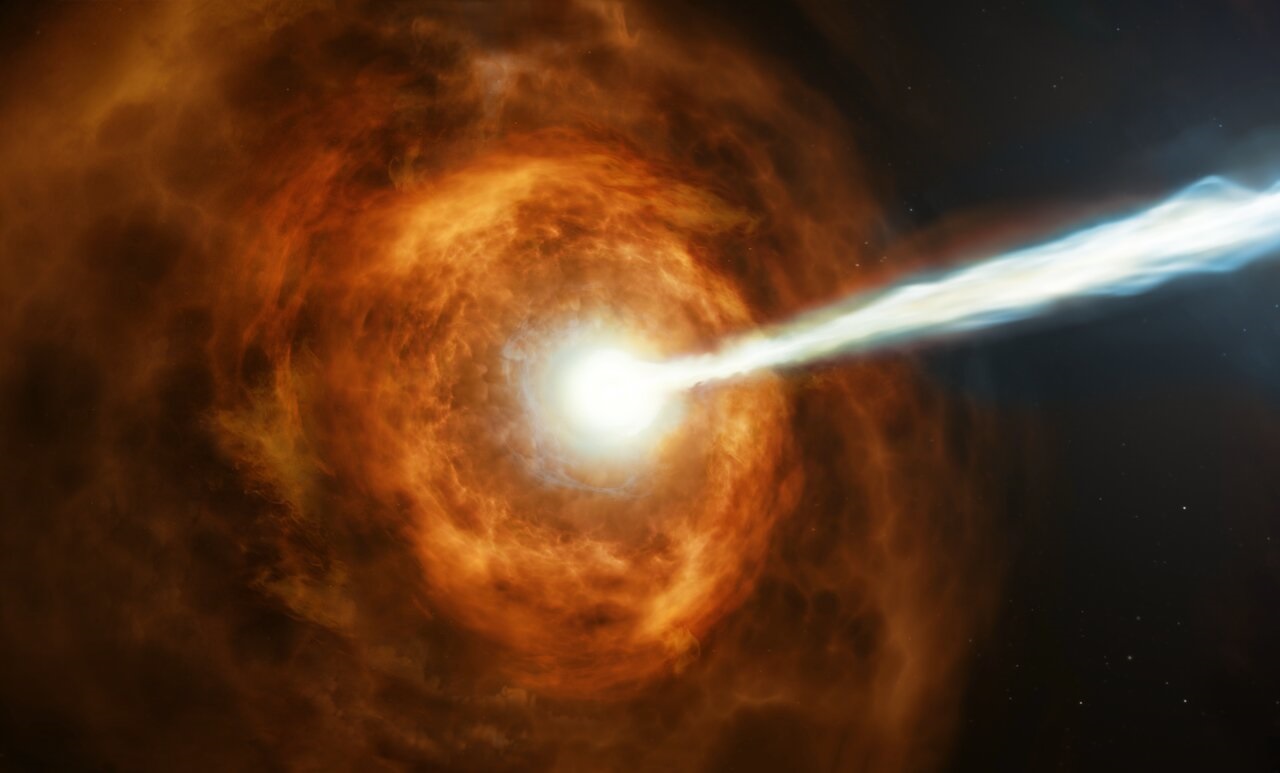Gamma-ray bursts (GRBs) are one of the most energetic phenomena in the Universe, and also one of the least researched. These explosions of energy occur when a massive star goes supernova and emits twin beams of gamma rays that can be seen billions of light-years away. Because they are closely tied with the formation of black holes, scientists have been eager to study this rare occurrence in greater detail.
Unfortunately, few opportunities for this have occurred since GRBs are very short-lived (lasting for just seconds) and most have happened in distant galaxies. But thanks to the efforts using a suite of telescopes, astronomers were able to spot a GRB (designated GRB 190114C) back in January of 2019. Some of the radiation from this GRB was the highest energy ever observed, making this a milestone in the history of astronomy.
The study that describes these findings (titled “Observation of inverse Compton emissions from a long gamma-ray burst“) recently appeared in the journal Nature and is due to appear in the journal Astronomy and Astrophysics. The study was led by Antonio de Ugarte Postigo of the Instituto de Astrofísica de Andalucía and included members of the MAGIC collaboration, NASA, and research institutes around the world.
To put it plainly, GRBs are actually quite common, occurring about once per day in the observable Universe. But because of their brief and fleeting nature, it has been very difficult to train instruments on the source before they disappear. But with the help of multiple telescopes that are optimized for gamma-ray detection, GRB 190114 was observed just in time.
This included NASA’s Neil Gehrels Swift Observatory, the Fermi Gamma-Ray Space Telescope, as well as the ground-based twin Major Atmospheric Gamma Imaging Cherenkov (MAGIC) telescopes – which is located on the Canary Island of La Palma and operated by the Max Planck Institute for Physics (MPP).
When these telescopes observed GRB 190114C, they observed that some of the energy released measured in the 1Tera electron volt (TeV) range – about one trillion times as much energy per photon observed with visible light. Based on previous observations, astronomers estimate that in order to achieve this energy level, material emitted from the collapsing star had to be traveling at 99.999% the speed of light.
In other words, material from a dying star would have to be accelerated to the very limits of what physical matter can endure in order to generate this kind of energetic burst. This material would then be forced through the gaseous clouds that surround the star (the remnants of the outer layers that have been blown off), causing a shock that creates the gamma-ray burst itself.
Scientists have been trying to observe extremely energetic emissions from GRB’s for a long time, and this particular burst provided the first-ever opportunity. As Dr. de Ugarte Postigo explained in an ESA/Hubble press release:
“Scientists have been trying to observe very-high-energy emission from gamma-ray bursts for a long time. This new observation is a vital step forward in our understanding of gamma-ray bursts, their immediate surroundings, and just how matter behaves when it is moving at 99.999% of the speed of light.”
Looking ahead, multiple space-based observatories will be observing the supernova that produced GRB 190114C to learn more about its environment and how this extreme burst was produced. In particular, European astronomers were provided observation time with the NASA/ESA Hubble Space Telescope to study the source environment.
These efforts were assisted by astronomers using the ESO’s Very Large Telescope (VLT) and the Atacama Large Milimeter/submilimeter Array (ALMA) in Chile. Combining their observations with the data obtained by Hubble, the astronomers were able to observe the host galaxy of this GRB (which is located 5 billion about light years from Earth) in greater detail.
As Andrew Levan of the Institute for Mathematics, Astrophysics & Particle Physics Department of Astrophysics at Radboud University in the Netherlands, explained:
“Hubble’s observations suggest that this particular burst was sitting in a very dense environment, right in the middle of a bright galaxy 5 billion light years away. This is really unusual, and suggests that might be why it produced this exceptionally powerful light.”
This milestone is a testament to the increasing capability of astronomical instruments and the growing importance of international cooperation. It is also in keeping with the current age of astronomy, where revolutionary discoveries are becoming more common. With every passing year, phenomena that were once poorly-understood or constrained are now being researched on a regular basis.
Further Reading: Hubble Space Telescope

